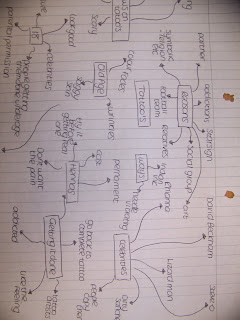Title of Programme:My Shocking Story
Type of Documentary:Mixed - Interviews, Actuality Footage, Archive Material.
Themes:Obesity and the problems it can cause in later life. (Americans).
Narrative Structure:Single Strand - The documentary is about one topic - obesity in children. Closed narrative - All the loose ends are tied up at the end of the documentary, the audience wern't left asking any questions, all answers were given.
Camera Work:Interviews were filmed to either the left or right hand side of the screen and were shot in Close-up or Medium Close-up. Over the shoulder shots were used throughout the documentary. Point of view shot over the state of Texas, America. Fast motion is used as children walk past.
Mise-en-scene:CHROMAKEY - Blue or green screen used as the backdrop for some of the interviews. Eyeline of the interviews was approximately 1/3 of the way up the screen. The boy Dexter has a very boyish bedroom; blue walls, football posters etc.
Sound:Voiceover - the narrator of the programme is male, old and speaks satndard English. No clear accent, he is used as the glue to hold the narrative together - he is used to tell the story and anchor the meaning. Relaxing, soothing music is used in the background. A train is heard going past at one point in the documentary.
Editing:Cut and cross cutting were the main editing used in this documentary, they used simple editing to keep the audiences attention on the story rather than them being distracted by too much fancy editing.
Archive Material:Canteen
Library
Fat Acadamy
Graphics:Graphics used to anchor who the people being interviewed were and their relevance to the topic. The text was always on the opposite side of the screen than the interviewee. The font and colour were plain (white) to prevent to much focus on them.
Title of Programme911 Falling Man
Type of Documentary
Mixed - Interviews, Actuality Footage, Archive Material
ThemesPower of the media/images, Media Controversy, Symbolism, Death, Fear and Personal reactions towards media.
Narrative StructureSingle Strand - The documentary is about one topic - obesity in children. Closed narrative - All the loose ends are tied up at the end of the documentary, the audience wern't left asking any questions, all answers were given. It is also non-linear and closed.
CameraworkInterviews are filmed with the interviewee to either the left or right hand side of the screen and they are in medium close up or close up, handheld camerawork is used for the archive material, Panning is not used on some of the images as it is not needed this is when the pictures are interesting and stand out the the audience already, although on some of the less interesting pictures panning, tracking and zooming is used.
Mise-en-sceneThe lighting in interviews is good as they are all well lit.
SoundThe narrator is male and sounds to be middle aged, he speaks in standard english and has a sympathetic sounding voice. Music is used in the background to anchor emotions
• Music to anchor emotions
• Radio/news broadcasts over footage
• Walky talky recordings from firemen
Editing
• Cut
• Fade to black
• Blur
Archive MaterialNews broadcasts
• Photographs
• Video footage of towers
Graphics• Name & relevance of person getting interviewed on opposite side of screen to the person
• Title of documentary, Simple, white font with black background


















